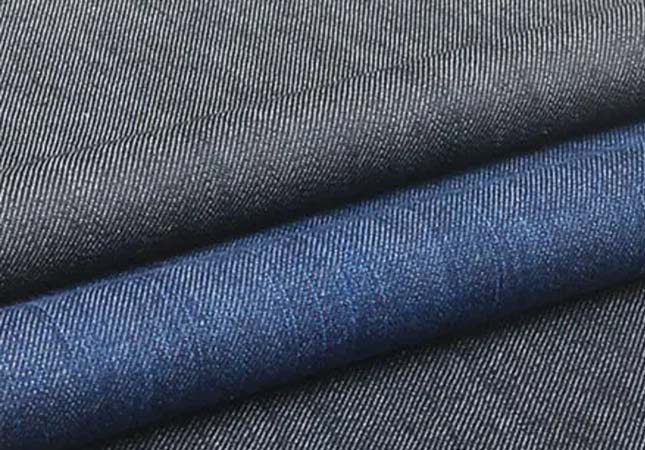Denim is a thick yarn-dyed warp twill cotton fabric that made of dark warp yarns, generally indigo blue and light weft yarns, generally light gray or scouring white yarns. It is a type of woven fabric produced by weaving machine, with thicker twill thicker on its surface, also known as denims fabrics.
It is a natural blend and chemical fiber cotton material that originated at western America and got its name from the use of trousers by herders. The warp yarn adopts sizing and dyeing combined with one-step dyeing process, and the special numbers are 80tex, 58tex, 36tex. The weft yarn is 96tex, 58tex, 48tex, using the weaving methods of 3/1 weave,variable twill, plain weave or crepe weave. The gray fabric has been shrink-proof finished so the shrinkage rate is smaller than that of ordinary fabrics with the tight texture and bright color, is suitable for the production of jeans, denim tops, denim vests, denim skirts.
Modern denim usually be added some spandex blended yarn in a very low content for improving the elasticity. Generally the content will not exceed 3%, otherwise there will be a rubber band feeling. A pure denim fabric will not contents other ingredients.

2 Types of Denim
1. Ring Spinning Denim
With the development and application of new equipment such as high-speed ring spinning and weaving machine, large packing machine, fine winding coupling, and knotless yarn, the shortcomings such as short length, low production efficiency of the coarse count yarn have been solved. Thus, the air yarns, used as the material in denim production, is replacing by ring-sun yarns, in a rapid speed. Additionally, compared with air yarns, ring-spun yarns have a nicer touching feelings, better drapability and nicer tear resistance, which made people psychologically return to nature and pursue the influence of the original developed denim style. And the ring spinning denim will generate a hazy bamboo pattern on its surface after being washed and processed, which is a popular pattern among current market so that promote itself to develop into a main denim type that be widely used in daily clothing.
2. Filling-Wise Elastic Denim
The growing applications of polyurethane elastic yarns have made the the denim variety developed into a new field. The fabrics that made by polyurethane elastic yarns are always closer to the body, more comfortable, and more suitable for fashion and personalized consumption requirements if combined with different colored bamboo pattern, which has greatly development potential.
Most of the elastic denim fabrics are weft elastic with the elastic elongation in 20% to 40% generally. The weaving pattern designs determine the size of the elastic elongation, usually the lower the tightness of weaving and weft on the weaving machine, the greater the elasticity. On the contrary, if fix the warp and weave tightness for increasing the tightness of the weft elastic yarn, then elasticity will become lower and even occur the loss of elasticity when the weft tightness reaches a certain level.
However, shrinkage is the main problem that of filling-wise elastic denim fabrics, generally reach to over 10% even as high as 20% in some cases.
There are 2 methods for solving this problem. The first one is to make the elastic elongation in a rather lower level during product design, generally in 20% to 30% for maintaining a certain warp and weft tissue tightness, and appropriately increasing the tension in the pre-shrinking finishing process for strengthening the fabric shrinkage ability. Another solution is to use heat-setting method after the elastic denim being pre-shrinking finishing, which can get a more uniform fabric width and relatively stabler and lower weft shrinkage for meeting the requirements of garment processing and production.




